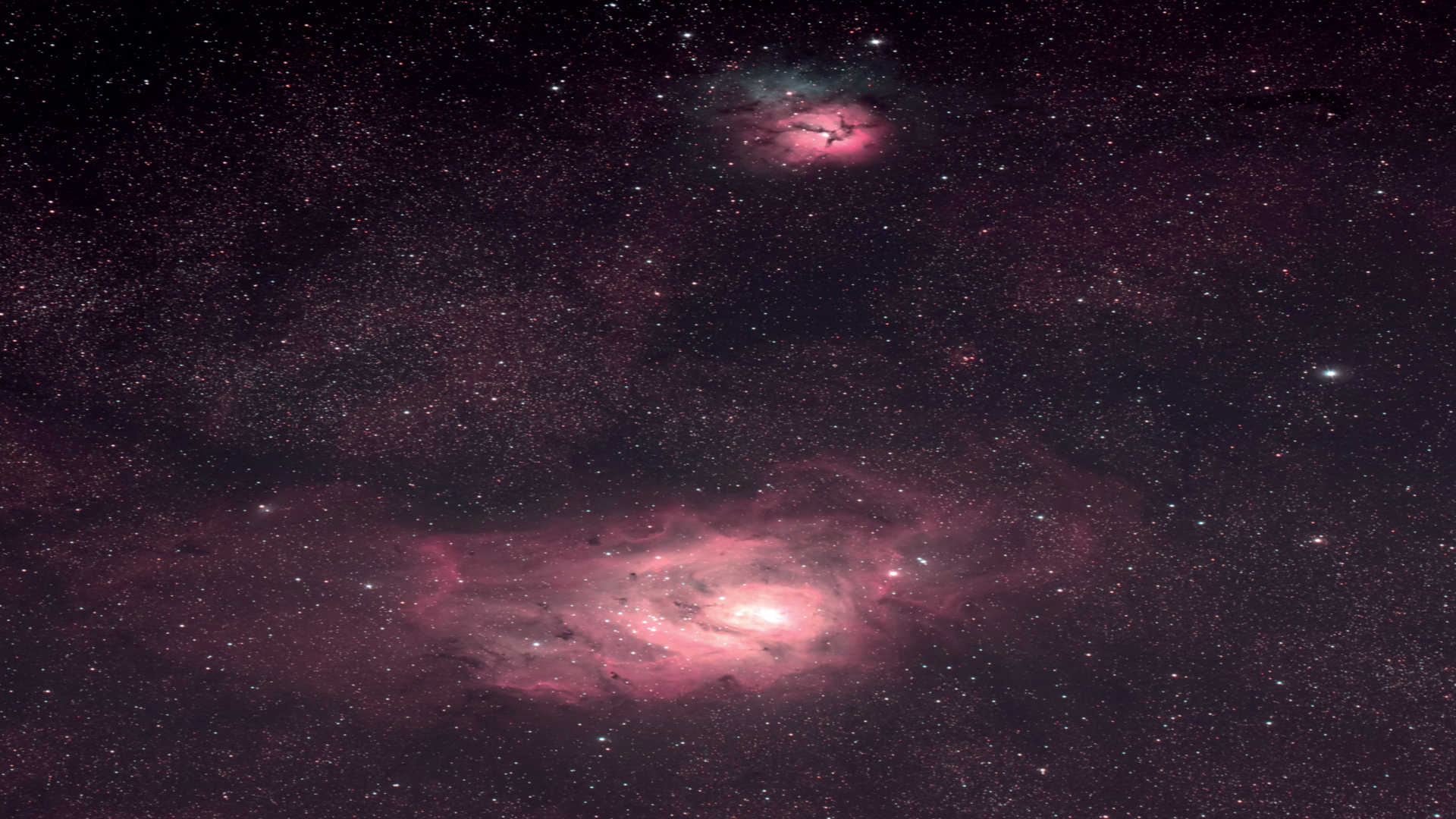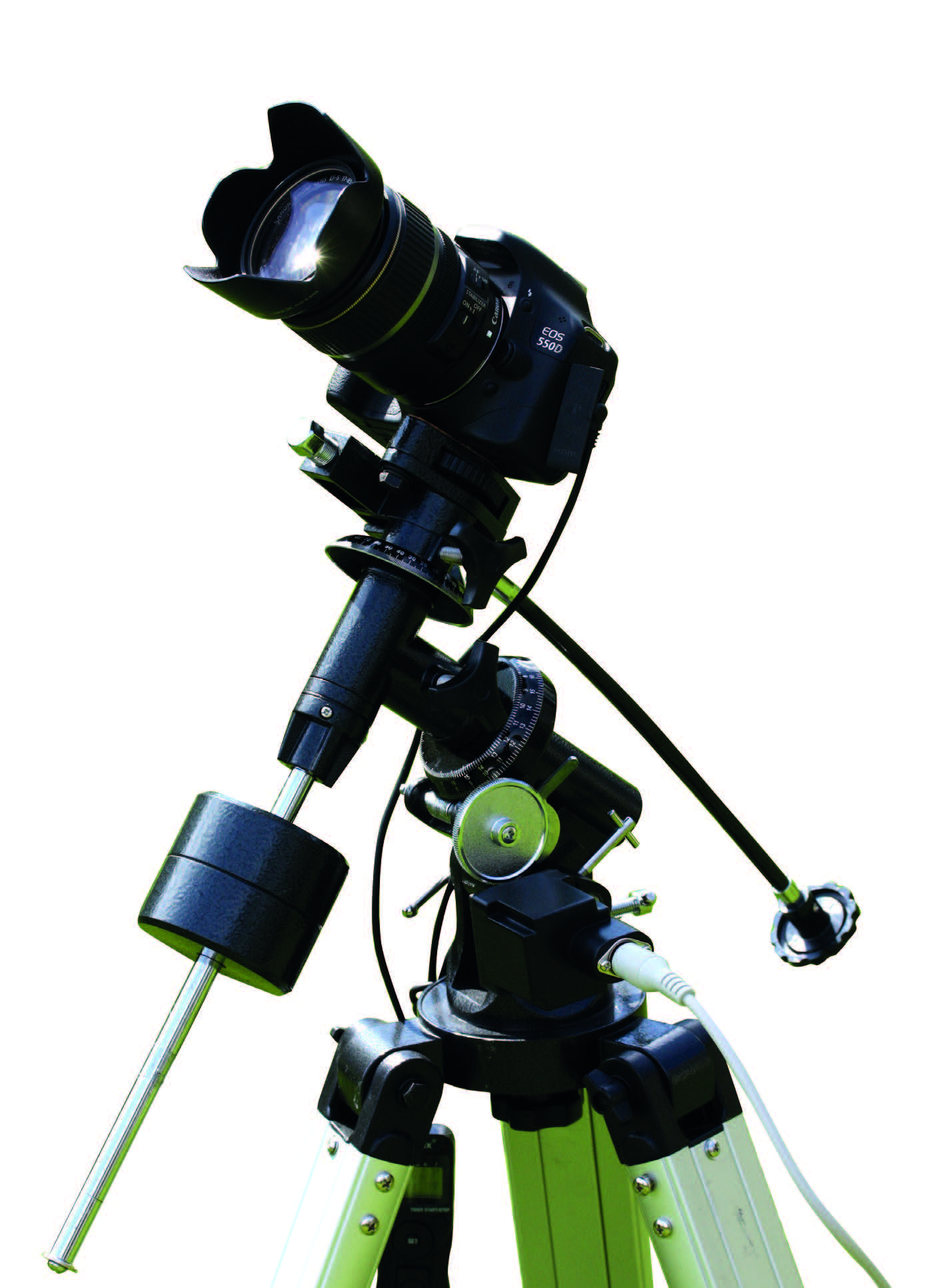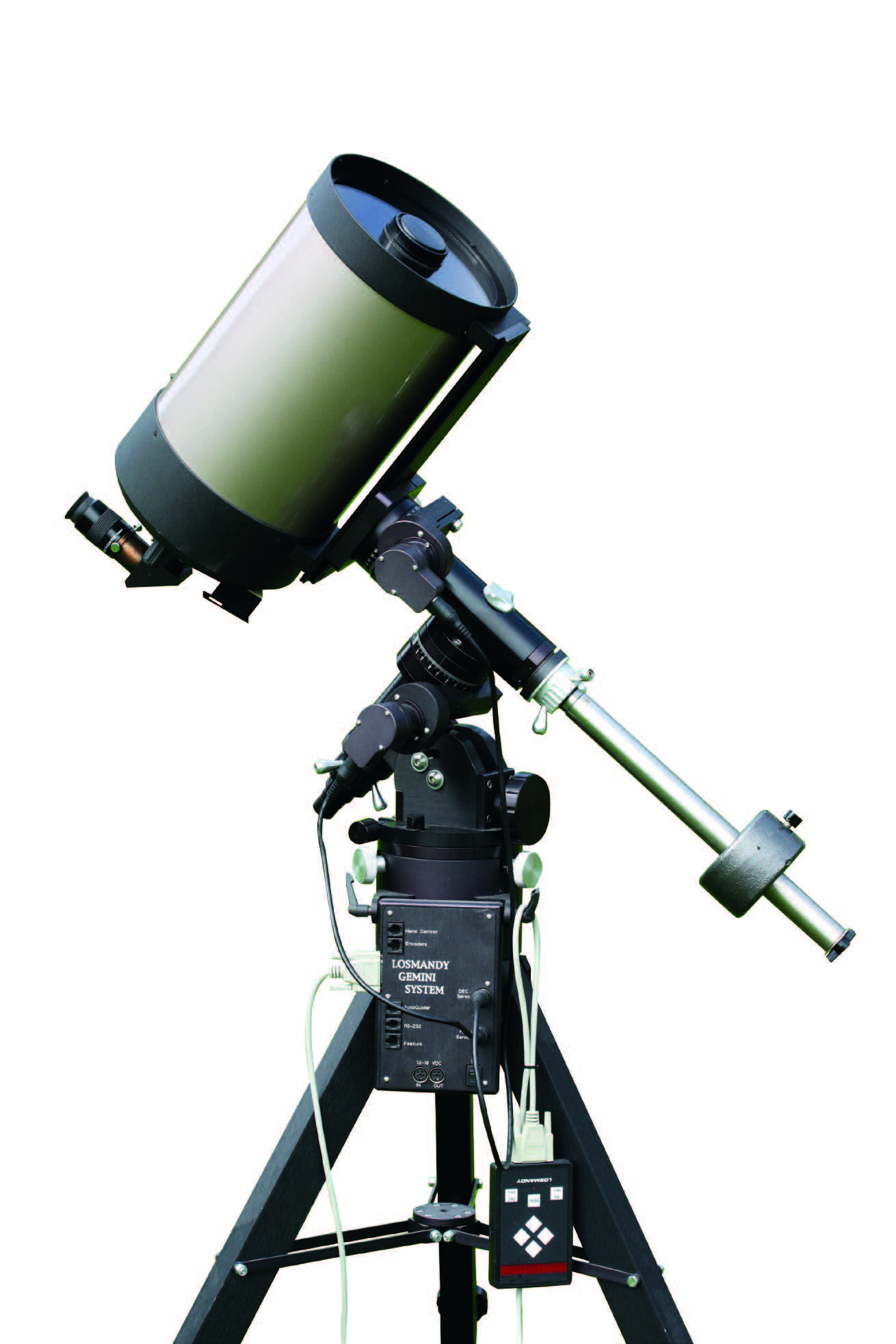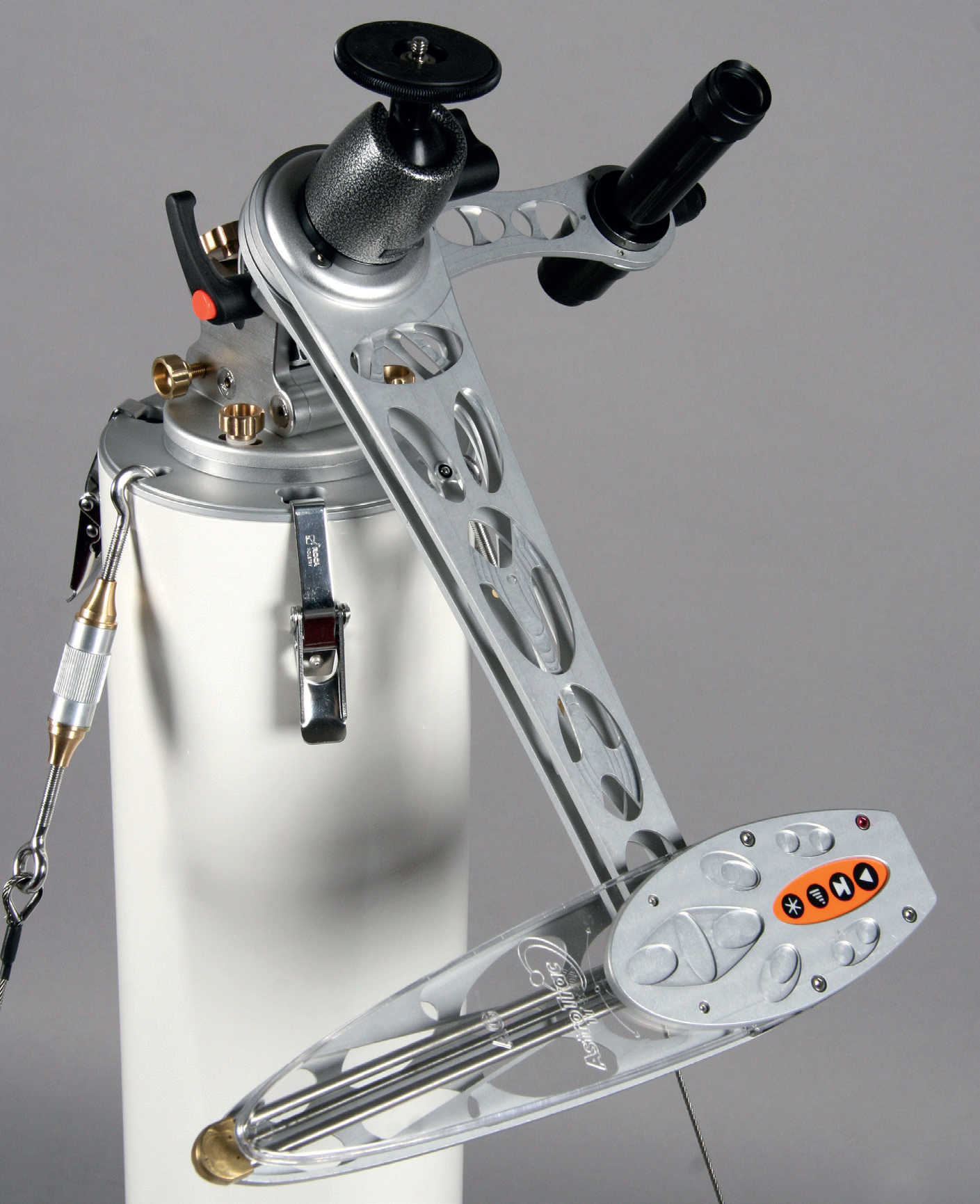It all depends on the mount!
Capturing deep sky objects requires longer exposure times. This places a number of demands on the mount.
 The Lagoon Nebula (Messier 8) together with the Trifid Nebula (Messier 20). The image was captured with an astrograph on an equatorial mount. The composite picture consists of eight images, each with an exposure time of 450 seconds.
The Lagoon Nebula (Messier 8) together with the Trifid Nebula (Messier 20). The image was captured with an astrograph on an equatorial mount. The composite picture consists of eight images, each with an exposure time of 450 seconds. An affordable EQ-2 equatorial mount carrying a DSLR with a lightweight telephoto lens. The counterweight on the axis, which compensates for the weight of the camera, is clearly visible. While the camera can be aligned in one axis with the flexible shaft (to the right in the picture), the second axis is driven by a motor to compensate for the rotation of the night sky. This combination works well for capturing star fields.
An affordable EQ-2 equatorial mount carrying a DSLR with a lightweight telephoto lens. The counterweight on the axis, which compensates for the weight of the camera, is clearly visible. While the camera can be aligned in one axis with the flexible shaft (to the right in the picture), the second axis is driven by a motor to compensate for the rotation of the night sky. This combination works well for capturing star fields.Altazimuth mounts, equatorial mounts, fork mounts, Dobsonian mounts, German mounts – the range of different telescope mounts is large and, at first glance, confusing. This article explains what to look for when choosing a mount for astrophotography.
Telescope mounts have the task of tracking the course of the stars in the night sky during an exposure which may be several hours in length. There are basically two types of mounts that, in different ways, are suitable for this task: altazimuth mounts and equatorial mounts.
Altazimuth mounts
 Here, a Schmidt Cassegrain telescope on a Losmandy GM-8 German mount is used for observing the Moon and planets. The mount is considerably more solid and therefore offers better load-bearing capability than the lightweight mount shown in picture 2. Both axes of this mount are motorised, and the mount also has GoTo functionality, which makes it possible to navigate to numerous celestial objects by computer control.
Here, a Schmidt Cassegrain telescope on a Losmandy GM-8 German mount is used for observing the Moon and planets. The mount is considerably more solid and therefore offers better load-bearing capability than the lightweight mount shown in picture 2. Both axes of this mount are motorised, and the mount also has GoTo functionality, which makes it possible to navigate to numerous celestial objects by computer control.Examples of altazimuth mounts can be found in the form of fork mounts for Schmidt Cassegrain telescopes or in the so-called rocker box style for Dobsonian telescopes. These types of mounts are popular since they do not need to be exactly aligned with the celestial pole and can therefore be quickly and easily set up for an evening of observation.
However, altazimuth mounts are not suitable, at least not initially, for astrophotography. Since the orientation of the camera's field of view relative to the horizon does not change, all stars will form a circular path around the central star (whose course in the night sky is being tracked). This is because, besides their daily movement, the stars are also moving in circular arcs across the sky. Even on the most carefully tracked images using an altazimuth mount, the rotation of the image field means that the stars will form trails in photographs with longer exposure times, which are considered image errors. However, additional mechanical products such as a polar wedge or a so-called equatorial platform can be used to convert altazimuth mounts in such a way that they can be used for photography.
Equatorial mount
 Equatorial mounts have also proven their worth as travel mounts. This battery-operated AstroTrac mount tracks the attached ball head for up to two hours to enable astrophotography at your holiday destination. The polar finder scope can be clearly seen on the right, which simplifies the alignment of the mount to the celestial pole.
Equatorial mounts have also proven their worth as travel mounts. This battery-operated AstroTrac mount tracks the attached ball head for up to two hours to enable astrophotography at your holiday destination. The polar finder scope can be clearly seen on the right, which simplifies the alignment of the mount to the celestial pole.Equatorial mounts are therefore commonly used for astrophotography. Once they have been appropriately set up, a pre-selected celestial object can be followed by rotation (tracking) in just one axis. This axis must be aligned parallel to the Earth’s axis. This is done by aligning this axis with the celestial pole visible from the observation site (i.e. in the northern hemisphere with the star Polaris), the centre of the daily rotation of the sky. Depending on the mount, a polar finder scope can be attached in – or parallel to – this axis for precise alignment. Some computer-controlled (and usually expensive) mounts allow the exact alignment even without such a polar finder scope.
The so-called German mount has proved its worth among the various equatorial mounts available. With this type of mount, the telescope tube together with the camera is attached to one end of the declination axis. The tilting moment resulting from the one-sided loading of the declination axis is compensated by a counterweight attached to the opposite end of the axis. To ensure that this counterweight does not simply represent additional dead weight which creates unnecessary load on the mount, it can be replaced, for example, by a camera for star field photography. Many mount manufacturers offer appropriate brackets among their accessories.
Are all mounts suitable for all objects?
With a precisely oriented and aligned equatorial mount, both long-exposure images of deep sky objects can be created, as well as the usually shorter exposure images of the objects of our solar system. Equatorial mounts require tracking in only one axis and are therefore fundamentally suitable for photographing all astronomical objects.
Altazimuth mounts, on the other hand, produce increasingly unattractive image field rotations with longer exposure times, which is why they are not suitable for deep sky images. However, they can be used for short-exposure shots of the Sun, Moon and planets, albeit with limitations: whether tracking errors in both axes spoil the resulting image will depend on the selected magnification and exposure time. To get started with astrophotography, to be on the safe side we recommend a stable equatorial mount for all types of night sky objects. When purchasing a mount for astrophotography, besides taking load-bearing capacity into account, you should also consider whether the objects to be photographed will be found by starhopping or whether you want to use a computer to locate objects. So-called GoTo mounts offer this convenient function. For longer exposure times, computer-controlled tracking is also necessary, so you should also look out for an autoguider connection when selecting your mount.
Author: Ullrich Dittler / Licence: Oculum-Verlag GmbH
